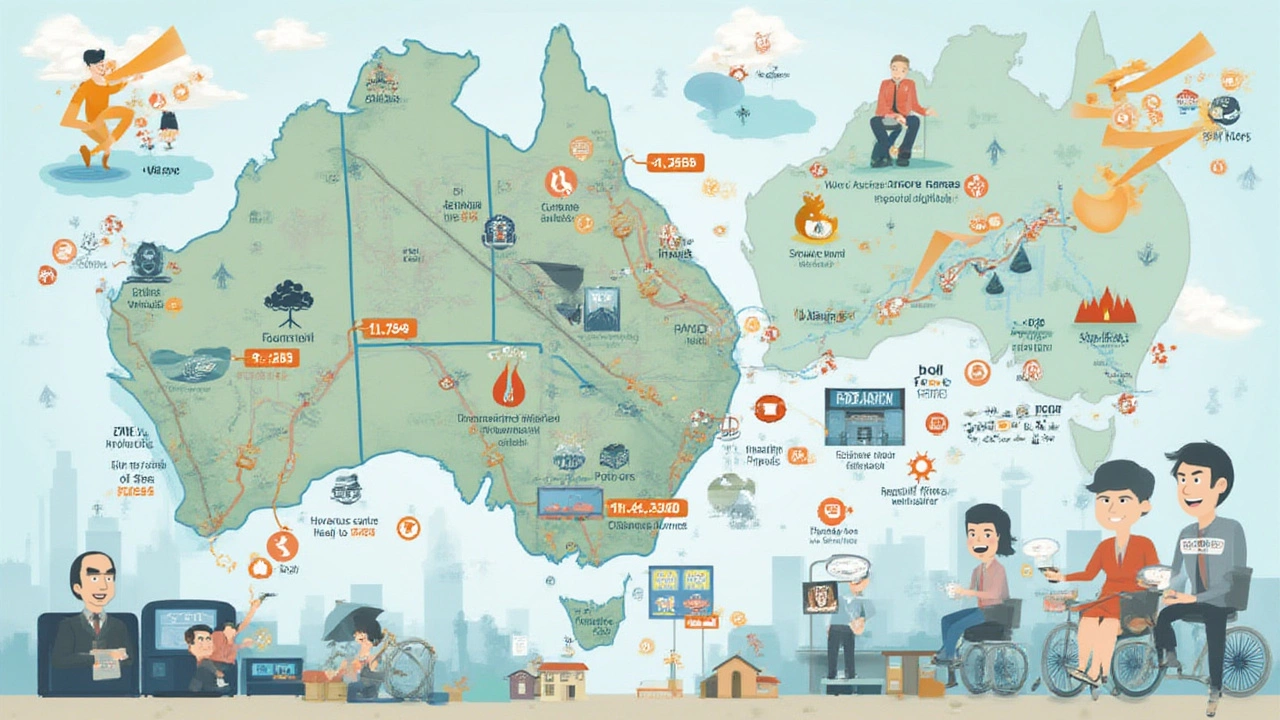If your eyes nearly popped out when you opened your 2024 homeowners insurance renewal, you’re definitely not alone. Social media has been full of screenshots showing massive hikes—sometimes more than 30% year on year. So, what on earth happened? And no, it’s not just your house or your suburb. Even Aussies with spotless claims records and newer homes saw the same jaw-dropping increases. Suddenly, it seems like everyone’s asking: why did my homeowners insurance go up so much in 2024?
What Pushed Homeowners Insurance Prices Up in 2024?
The most obvious culprit? Extreme weather. 2023 was brutal for Australian property insurers—think about those summer storms that hit Queensland and northern NSW, the flash floods in Victoria, and that freak hailstorm near Perth that shredded roofs like paper. It’s not some distant climate theory either; the Insurance Council of Australia reported a record $3.2 billion in insured losses just from natural disasters last year. That’s staggering, even for seasoned insurers. The more they pay out, the more they collect from us to make up the shortfall.
But that’s only part of the picture. Reinsurance costs—that’s what insurance companies pay to cover their own risks—also skyrocketed in 2023 and again in early 2024. Munich Re and Swiss Re, two of the biggest players globally, raised their premiums by up to 30%. Aussie insurers like Suncorp, IAG, and QBE have all said their own costs jumped two or even three times the usual rate. One actuary likened it to keeping an emergency fund, but suddenly the piggy bank fees have doubled overnight.
Another huge factor? The cost of building materials and labour. A simple repair that cost $20,000 before COVID now averages closer to $34,000 according to CoreLogic and the Master Builders Association. Timber, steel, and bricks are still pricier than pre-pandemic, mostly thanks to lingering supply chain headaches from China and ongoing demand. When repair bills are higher, your home insurance has to keep pace. Even if you haven’t claimed recently, tomorrow’s claims are predicted to be far more expensive, so your premiums go up either way.
You might think, “I haven’t made a claim, so why am I getting slugged?” Insurance really is a community pot. Your neighbours’ misfortune affects you whether you know them or not. The more claims the insurer pays across the board, the more everyone chips in—no exceptions if you’re claim-free.
There’s also a legal shake-up. Last year saw stricter building codes for risk-prone zones, especially along the coasts and fire-prone bushland. If you live anywhere near a potential hazard zone, insurers automatically recalculated their risk—often not in your favour. Plus, the recent ASIC (Australian Securities & Investments Commission) crackdown forced companies to better explain risk pricing, which in practice meant: everyone gets a bespoke, sometimes steeper, bill.

The Numbers: How Much Have Prices Actually Risen?
If you want specifics—and who doesn’t—you’ll find some grim stats in black and white. The Australian Competition & Consumer Commission (ACCC) revealed in March 2024 that average home insurance premiums for standalone houses jumped from $1,700 in 2023 to $2,190 in 2024. That’s a 28.8% increase—almost five times inflation.
Here’s a handy table to break down the price jumps in different states:
| State/Territory | Average 2023 Premium (AUD) | Average 2024 Premium (AUD) | Percentage Increase |
|---|---|---|---|
| New South Wales | 1,620 | 2,060 | 27.1% |
| Victoria | 1,580 | 2,025 | 28.1% |
| Queensland | 2,150 | 2,968 | 38.0% |
| Western Australia | 1,430 | 1,850 | 29.4% |
| South Australia | 1,210 | 1,445 | 19.4% |
| Tasmania | 1,130 | 1,350 | 19.4% |
The sharpest spike was in North Queensland—no surprises, right, given how cyclone-prone and flood-hit regions copped the brunt of disasters. Some locals saw their bills jump by more than $1,200 in a single year. Even coastal NSW and Melbourne’s leafy outer suburbs weren’t spared—everywhere is feeling the crunch.
What really stings is that insurance is starting to outpace pay rises. ABS wage data shows household incomes have only crept up by about 4%, while insurance costs grew at 7 times that amount. No wonder so many families are weighing up whether to cut back their cover—or even skip insurance altogether. In fact, a Roy Morgan survey found that by May 2024, almost 11% of mortgage holders let their home insurance lapse just to save money. That’s risky, but it tells you how the cost pressure is biting.
Don’t forget special risk factors. Pool owners, homes with mature leafy trees, and those in older houses (especially pre-1985) have been targeted for even higher jumps—some as high as 50%. And if you recently switched to short-term rentals (like listing on Airbnb), you likely saw a surcharge or even a coverage refusal, as insurers see those homes as higher risk now than ever.

Smart Moves: What Can You Do About Higher Homeowners Insurance?
Feeling cornered by rising insurance bills isn’t fun, but you’re not stuck. There are ways to soften the blow. The most obvious step is to actually shop around—something about 7 in 10 Aussies still don’t do. Every insurer uses its own risk model, so while one might see your postcode as high risk, another may not. And don’t just get one compare quote—try at least three.
Think about your excess (or deductible for the US crowd). Raising your standard excess from $500 to $1,500 can knock hundreds off your yearly premium. Of course, you’ll be out of pocket if you need to claim, so balance what you can afford today against a worst-case scenario.
Consider bundling. Combining your contents, car, and home buildings insurance can lead to discounts, often 10-15%. Not always, but worth checking—just watch out for gotchas if you drop one policy later.
Prove you’re less risky. Some insurers now offer real discounts if you add or upgrade smoke alarms, storm shutters, sprinkler systems, or even if you verify a new quality roof install. If you’ve done a big reno recently that lowers your risk, ask about a reassessment—don’t wait for the insurer to offer it.
Paying annually can trim a little off your bill instead of monthly. Not a game-changer, but every bit helps when costs are surging.
One handy tip: Check if your local council is part of the national Disaster Ready Fund. Some councils are now rolling out local flood levees, bushfire breaks, or stormwater upgrades, and partnering insurers sometimes offer small rebates for residents in those areas. It’s not huge money but better than nothing.
Don’t be afraid to haggle. A 2023 Finder survey found nearly a third of people who asked for a lower premium actually got one. Insurers know it’s a shoppers’ market, especially with so many folks threatening to cancel or downsize their cover.
If you’re desperate, there’s the nuclear option: raise your excess, reduce optional extras (like accidental damage), or even cover just the core structure, skipping non-essential coverages—though this should be a last resort, not a go-to strategy.
The most important thing? Don’t assume next year’s bill will magically drop. Extreme weather damages, wild swings in building costs, and global reinsurance woes aren’t going to vanish overnight. Your next renewal will probably reflect whatever disasters and trends hit in 2025 too. So get proactive, check your policy, gather fresh quotes, and don’t pay more than you must. Homeowners insurance isn’t going to get any cheaper soon, but with a few smart moves, you can keep more in your own pocket.
Insurance nerds might say, "You only notice insurance once you make a claim." But let’s be real: in 2024, everyone’s noticing—claim or no claim. Keep your wits about you and don’t take that renewal at face value. Now you know what’s happening behind the bill, you’ve got a fighting chance to make it work for you.
